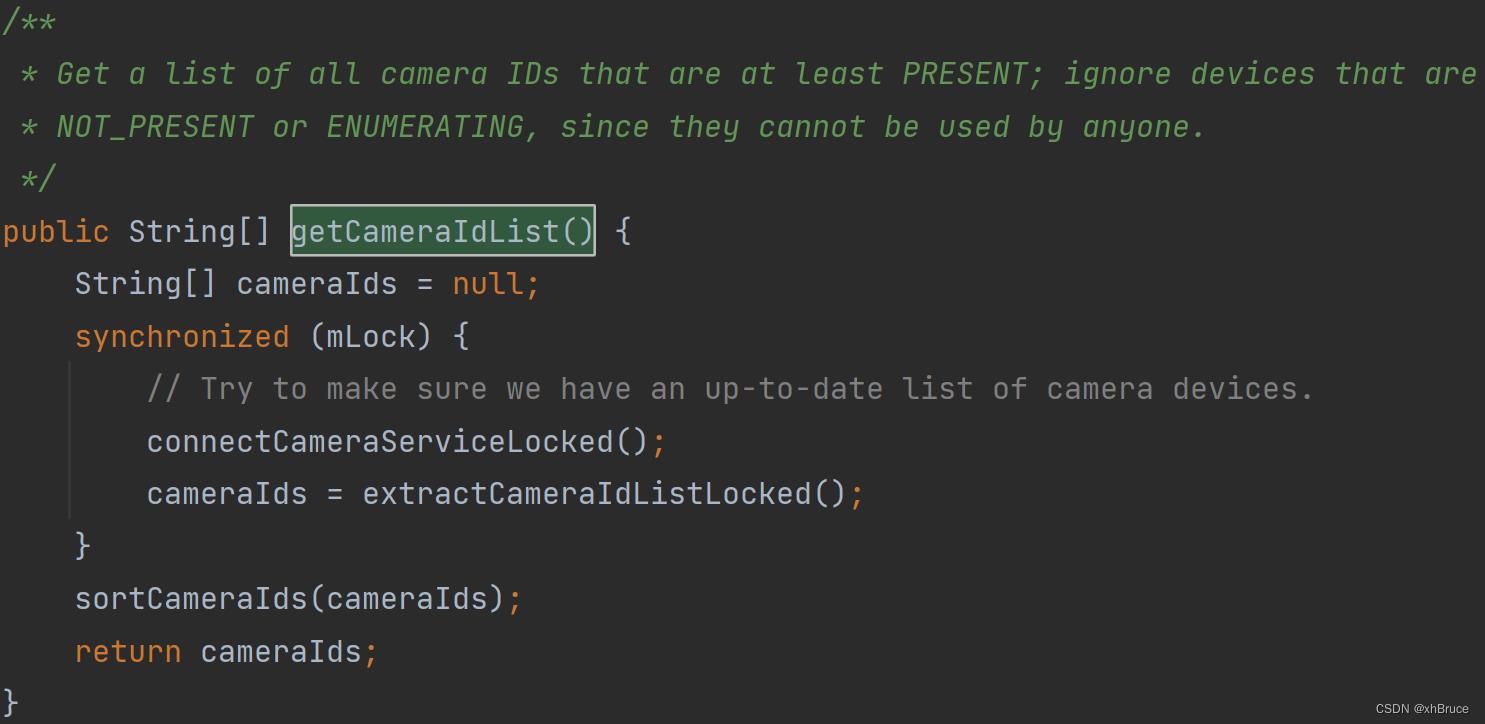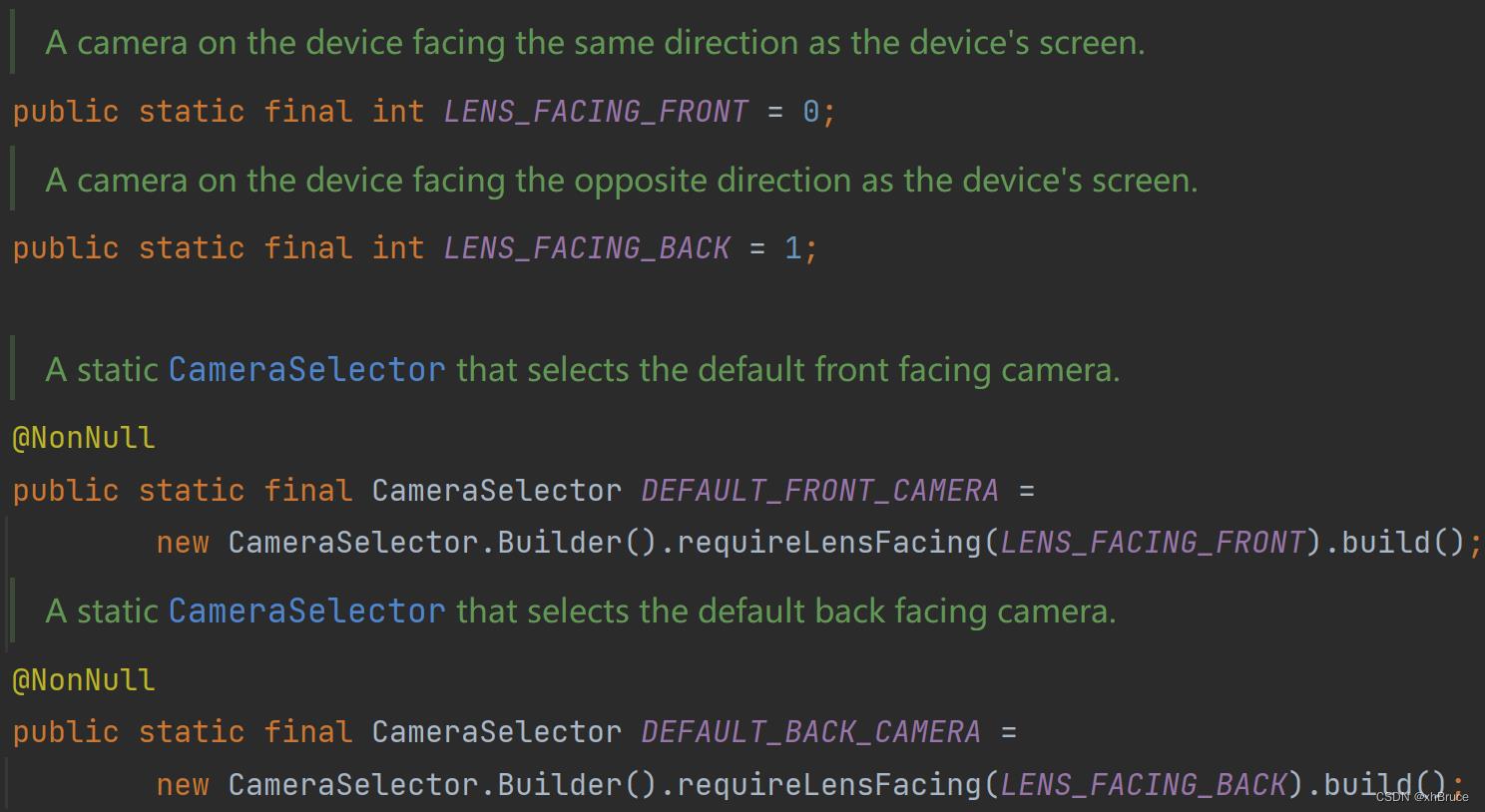APP使用相机CameraX
Posted xhBruce
tags:
篇首语:本文由小常识网(cha138.com)小编为大家整理,主要介绍了APP使用相机CameraX相关的知识,希望对你有一定的参考价值。
APP使用相机
| Sample | Description |
|---|---|
| CameraXBasic | Demonstrates how to use CameraX APIs. |
| CameraXAdvanced | Demonstrates how to use CameraX APIs with TFLite and others |
| CameraXVideo | Demonstrates how to use CameraX VideoCapture API. |
| Camera2Basic | Demonstrates capturing JPEG, RAW and DEPTH images, e.g. unprocessed pixel data directly from the camera sensor. |
| Camera2SlowMotion | Demonstrates capturing high-speed video in a constrained camera capture session. |
| Camera2Video | Demonstrates recording video using the Camera2 API and MediaRecorder. |
| Camera2Extensions | Demonstrates Camera2 extension live preview and still capture. |
| HdrViewfinder | Demonstrates use of RenderScript to display a live HDR feed from camera frames using Camera2 API. |
0. CameraX 概览 | android Jetpack 的一部分
1. CameraX获取Context.CAMERA_SERVICE服务
CameraXBasic 的
setUpCamera()方法第一次调用 ProcessCameraProvider.getInstance() 期间,初始化 CameraX 会cameraFactory.getAvailableCameraIds()枚举和查询设备上可用摄像头的特性。
其中cameraFactory在com/android/example/cameraxbasic/MainApplication.kt中调用CameraXConfig.Builder.fromConfig(Camera2Config.defaultConfig())初始化对象Camera2CameraFactory、CameraXConfig
1.1 获取Context.CAMERA_SERVICE服务
下面获取Context.CAMERA_SERVICE服务,实际获取 SystemServiceRegistry.java中注册的CameraManager.java。通过CameraManagerGlobal连接CameraService
androidx/camera/camera2/internal/Camera2CameraFactory.java
androidx/camera/camera2/internal/compat/CameraManagerCompat.java
androidx/camera/camera2/internal/compat/CameraManagerCompatApi29Impl.java
androidx/camera/camera2/internal/compat/CameraManagerCompatApi28Impl.java
androidx/camera/camera2/internal/compat/CameraManagerCompatBaseImpl.java


frameworks/base/core/java/android/app/SystemServiceRegistry.java

frameworks/base/core/java/android/hardware/camera2/CameraManager.java
public ICameraService getCameraService()
synchronized(mLock)
connectCameraServiceLocked();
if (mCameraService == null && !sCameraServiceDisabled)
Log.e(TAG, "Camera service is unavailable");
return mCameraService;
private void connectCameraServiceLocked()
// Only reconnect if necessary
if (mCameraService != null || sCameraServiceDisabled) return;
Log.i(TAG, "Connecting to camera service");
IBinder cameraServiceBinder = ServiceManager.getService(CAMERA_SERVICE_BINDER_NAME);
if (cameraServiceBinder == null)
// Camera service is now down, leave mCameraService as null
return;
try
cameraServiceBinder.linkToDeath(this, /*flags*/ 0);
catch (RemoteException e)
// Camera service is now down, leave mCameraService as null
return;
ICameraService cameraService = ICameraService.Stub.asInterface(cameraServiceBinder);
try
CameraMetadataNative.setupGlobalVendorTagDescriptor();
catch (ServiceSpecificException e)
handleRecoverableSetupErrors(e);
try
CameraStatus[] cameraStatuses = cameraService.addListener(this);
for (CameraStatus c : cameraStatuses)
onStatusChangedLocked(c.status, c.cameraId);
if (c.unavailablePhysicalCameras != null)
for (String unavailPhysicalCamera : c.unavailablePhysicalCameras)
onPhysicalCameraStatusChangedLocked(
ICameraServiceListener.STATUS_NOT_PRESENT,
c.cameraId, unavailPhysicalCamera);
mCameraService = cameraService;
catch(ServiceSpecificException e)
// Unexpected failure
throw new IllegalStateException("Failed to register a camera service listener", e);
catch (RemoteException e)
// Camera service is now down, leave mCameraService as null
try
ConcurrentCameraIdCombination[] cameraIdCombinations =
cameraService.getConcurrentCameraIds();
for (ConcurrentCameraIdCombination comb : cameraIdCombinations)
mConcurrentCameraIdCombinations.add(comb.getConcurrentCameraIdCombination());
catch (ServiceSpecificException e)
// Unexpected failure
throw new IllegalStateException("Failed to get concurrent camera id combinations",
e);
catch (RemoteException e)
// Camera service died in all probability
1.2 枚举和查询设备上可用摄像头
CameraX 初始化时
cameraFactory.getAvailableCameraIds()枚举和查询设备上可用摄像头的特性。最终调用CameraSelectionOptimizer.getSelectedAvailableCameraIds(this, availableCamerasSelector)通过cameraFactory.getCameraManager().getCameraIdList()获取。
FWK层中CameraManager.java中CameraManagerGlobal的getCameraIdList():connectCameraServiceLocked()连接CameraService服务CAMERA_SERVICE_BINDER_NAME = "media.camera"
摄像头限制器 如果传递给 CameraXConfig.Builder.setAvailableCamerasLimiter() 的 CameraSelector 过滤掉了某个摄像头,则 CameraX 在运行时会假定该摄像头不存在。CameraSelector.DEFAULT_BACK_CAMERA后置摄像头LENS_FACING_BACK = 1;CameraSelector.DEFAULT_FRONT_CAMERA前置摄像头LENS_FACING_FRONT = 0。
com/android/example/cameraxbasic/fragments/CameraFragment.kt
androidx/camera/core/CameraX.java
androidx/camera/core/impl/CameraRepository.java
public void init(@NonNull CameraFactory cameraFactory) throws InitializationException
synchronized (mCamerasLock)
try
Set<String> camerasList = cameraFactory.getAvailableCameraIds();
for (String id : camerasList)
Logger.d(TAG, "Added camera: " + id);
mCameras.put(id, cameraFactory.getCamera(id));
catch (CameraUnavailableException e)
throw new InitializationException(e);
androidx/camera/camera2/internal/Camera2CameraFactory.java
public Camera2CameraFactory(@NonNull Context context,
@NonNull CameraThreadConfig threadConfig,
@Nullable CameraSelector availableCamerasSelector) throws InitializationException
mThreadConfig = threadConfig;
mCameraStateRegistry = new CameraStateRegistry(DEFAULT_ALLOWED_CONCURRENT_OPEN_CAMERAS);
mCameraManager = CameraManagerCompat.from(context, mThreadConfig.getSchedulerHandler());
List<String> optimizedCameraIds = CameraSelectionOptimizer.getSelectedAvailableCameraIds(
this, availableCamerasSelector);
mAvailableCameraIds = getBackwardCompatibleCameraIds(optimizedCameraIds);
public Set<String> getAvailableCameraIds()
// Use a LinkedHashSet to preserve order
return new LinkedHashSet<>(mAvailableCameraIds);
androidx/camera/camera2/internal/CameraSelectionOptimizer.java
static List<String> getSelectedAvailableCameraIds(
@NonNull Camera2CameraFactory cameraFactory,
@Nullable CameraSelector availableCamerasSelector)
throws InitializationException
try
List<String> availableCameraIds = new ArrayList<>();
List<String> cameraIdList =
Arrays.asList(cameraFactory.getCameraManager().getCameraIdList());
if (availableCamerasSelector == null)
for (String id : cameraIdList)
availableCameraIds.add(id);
return availableCameraIds;
// Skip camera ID by heuristic: 0 is back lens facing, 1 is front lens facing.
String skippedCameraId;
try
Integer lensFacingInteger = availableCamerasSelector.getLensFacing();
skippedCameraId = decideSkippedCameraIdByHeuristic(
cameraFactory.getCameraManager(), lensFacingInteger, cameraIdList);
catch (IllegalStateException e)
// Don't skip camera if there is any conflict in camera lens facing.
skippedCameraId = null;
List<CameraInfo> cameraInfos = new ArrayList<>();
for (String id : cameraIdList)
if (id.equals(skippedCameraId))
continue;
Camera2CameraInfoImpl cameraInfo = cameraFactory.getCameraInfo(id);
cameraInfos.add(cameraInfo);
List<CameraInfo> filteredCameraInfos =
availableCamerasSelector.filter(cameraInfos);
for (CameraInfo cameraInfo : filteredCameraInfos)
String cameraId = ((CameraInfoInternal) cameraInfo).getCameraId();
availableCameraIds.add(cameraId);
return availableCameraIds;
catch (CameraAccessExceptionCompat e)
throw new InitializationException(CameraUnavailableExceptionHelper.createFrom(e));
catch (CameraUnavailableException e)
throw new InitializationException(e);
2. 拍照按钮执行
除了
setUpCamera()初始化CameraX,其中重要查看updateCameraUi()布局更新;camera_capture_button按钮cameraUiContainerBinding?.cameraCaptureButton?.setOnClickListener设置
com/android/example/cameraxbasic/fragments/CameraFragment.kt
// Listener for button used to capture photo
cameraUiContainerBinding?.cameraCaptureButton?.setOnClickListener
// Get a stable reference of the modifiable image capture use case
imageCapture?.let imageCapture ->
// Create output file to hold the image
val photoFile = createFile(outputDirectory, FILENAME, PHOTO_EXTENSION)
// Setup image capture metadata
val metadata = Metadata().apply
// Mirror image when using the front camera
isReversedHorizontal = lensFacing == CameraSelector.LENS_FACING_FRONT
// Create output options object which contains file + metadata
val outputOptions = ImageCapture.OutputFileOptions.Builder(photoFile)
.setMetadata(metadata)
.build()
// Setup image capture listener which is triggered after photo has been taken
imageCapture.takePicture(
outputOptions, cameraExecutor, object : ImageCapture.OnImageSavedCallback
override fun onError(exc: ImageCaptureException)
Log.e(TAG, "Photo capture failed: $exc.message", exc)
override fun onImageSaved(output: ImageCapture.OutputFileResults)
val savedUri = output.savedUri ?: Uri.fromFile(photoFile)
Log.d(TAG, "Photo capture succeeded: $savedUri")
// We can only change the foreground Drawable using API level 23+ API
if (Build.VERSION.SDK_INT >= Build.VERSION_CODES.M)
// Update the gallery thumbnail with latest picture taken
setGalleryThumbnail(savedUri)
// Implicit broadcasts will be ignored for devices running API level >= 24
// so if you only target API level 24+ you can remove this statement
if (Build.VERSION.SDK_INT < Build.VERSION_CODES.N)
requireActivity().sendBroadcast(
Intent(android.hardware.Camera.ACTION_NEW_PICTURE, savedUri)
)
// If the folder selected is an external media directory, this is
// unnecessary but otherwise other apps will not be able to access our
// images unless we scan them using [MediaScannerConnection]
val mimeType = MimeTypeMap.getSingleton()
.getMimeTypeFromExtension(savedUri.toFile().extension)
MediaScannerConnection.scanFile(
context,
arrayOf(savedUri.toFile().absolutePath),
arrayOf(mimeType)
) _, uri ->
Log.d(TAG, "Image capture scanned into media store: $uri")
)
// We can only change the foreground Drawable using API level 23+ API
if (Build.VERSION.SDK_INT >= Build.VERSION_CODES.M)
// Display flash animation to indicate that photo was captured
fragmentCameraBinding.root.postDelayed(
fragmentCameraBinding.root.foreground = ColorDrawable(Color.WHITE)
fragmentCameraBinding.root.postDelayed(
fragmentCameraBinding.root.foreground = null , ANIMATION_FAST_MILLIS)
, ANIMATION_SLOW_MILLIS)
3. 前置/后置 摄像头切换
查看
updateCameraUi()布局更新;camera_switch_button按钮cameraUiContainerBinding?.cameraSwitchButton?.let设置,CameraSelector.LENS_FACING_BACK、CameraSelector.LENS_FACING_FRONT前后置属性,bindCameraUseCases()更新预览preview、捕获imageCapture和分析imageAnalyzer用例;observeCameraState(camera?.cameraInfo!!)监听Camera状态
com/android/example/cameraxbasic/fragments/CameraFragment.kt
// Setup for button used to switch cameras
cameraUiContainerBinding?.cameraSwitchButton?.let
// Disable the button until the camera is set up
it.isEnabled = false
// Listener for button used to switch cameras. Only called if the button is enabled
it.setOnClickListener
lensFacing = if (CameraSelector.LENS_FACING_FRONT == lensFacing)
CameraSelector.LENS_FACING_BACK
else
CameraSelector.LENS_FACING_FRONT
// Re-bind use cases to update selected camera
bindCameraUseCases()
/** Declare and bind preview, capture and analysis use cases */
private fun bindCameraUseCases()
// Get screen metrics used to setup camera for full screen resolution
val metrics = windowManager.getCurrentWindowMetrics().bounds
Log.d(TAG, "Screen metrics: $metrics.width() x $metrics.height()")
val screenAspectRatio = aspectRatio(metrics.width(), metrics.height())
Log.d(TAG, "Preview aspect ratio: $screenAspectRatio")
val rotation = fragmentCameraBinding.viewFinder.display.rotation
// CameraProvider
val cameraProvider = cameraProvider
?: throw IllegalStateException("Camera initialization failed.")
// CameraSelector
val cameraSelector = CameraSelector.Builder().requireLensFacing(lensFacing).build()
// Preview
preview = Preview.Builder()
// We request aspect ratio but no resolution
.setTargetAspectRatio(screenAspectRatio)
// Set initial target rotation
.setTargetRotation(rotation)
.build()
// ImageCapture
imageCapture = ImageCapture.Builder()
.setCaptureMode(ImageCapture.CAPTURE_MODE_MINIMIZE_LATENCY)
// We request aspect ratio but no resolution to match preview config, but letting
// CameraX optimize for whatever specific resolution best fits our use cases
.setTargetAspectRatio(screenAspectRatio)
// Set initial target rotation, we will have to call this again if rotation changes
// during the lifecycle of this use case
.setTargetRotation(rotation)
.build()
// ImageAnalysis
imageAnalyzer = ImageAnalysis.Builder()
// We request aspect ratio but no resolution
.setTargetAspectRatio(screenAspectRatio)
// Set initial target rotation, we will have to call this again if rotation changes
// during the lifecycle of this use case
.setTargetRotation(rotation)
.build()
// The analyzer can then be assigned to the instance
.also
it.setAnalyzer(cameraExecutor, LuminosityAnalyzer luma ->
// Values returned from our analyzer are passed to the attached listener
// We log image analysis results here - you should do something useful
// instead!
Log.d(TAG, "Average luminosity: $luma")
)
// Must unbind the use-cases before rebinding them
cameraProvider.unbindAll()
try
// A variable number of use-cases can be passed here -
// camera provides access to CameraControl & CameraInfo
camera = cameraProvider.bindToLifecycle(
this, cameraSelector, preview, imageCapture, imageAnalyzer)
// Attach the viewfinder's surface provider to preview use case
preview?.setSurfaceProvider(fragmentCameraBinding.viewFinder.surfaceProvider)
observeCameraState(camera?.cameraInfo!!)
catch (exc: Exception)
Log.e(TAG, "Use case binding failed"以上是关于APP使用相机CameraX的主要内容,如果未能解决你的问题,请参考以下文章
Android进阶宝典 -- CameraX与Camera2的使用比对

